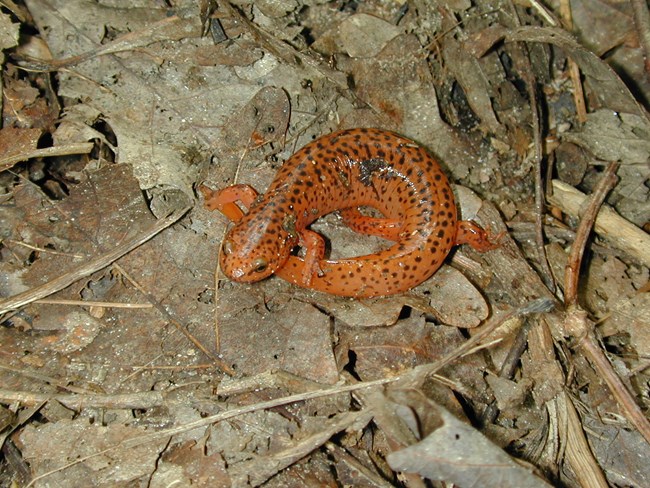
NPS Photo Family: Plethodontidae Pseudotriton ruber Red Salamander
Size: 9.6 to 18.2 cm long (3 ¾" to 7 ¼") General Description: Relatively large and stout, red, orange-brown to purple-brown colored body that has many irregular black spots on the back. Yellow eyes. Juveniles may be coral-red to reddish-orange in color, typically brighter than adults and may lack spots on their bellies. Back and belly colors blend along sides. Belly spotted with brown or black, more so in older animals. Chin also spotted with black along edges. Color may darken and spots may run together as animal ages. Legs relatively short. Tail only 38% of total length on average. 16 to 17 costal grooves. Larvae are aquatic and have stream-type morphology. Newly transformed juveniles develop adult spotting pattern within a few months. Similar Species: Mud Salamander, P. montanus, has round spots and black eyes. Reproduction: Breeding season is variable dependant on geographic location. Breeding can occur any time of year, except during the coldest months. Habitat: Commonly found under rocks or leaf litter in cool forested areas near water; springs, seepages, brooks, swamps, meadows, etc. May also be found some distance away from water. Found from sea level up to elevations of 1, 524 m (5, 000') or more. Behavior: Larvae typically reside in areas of slow moving water with lots of debris where they feed on worms, aquatic invertebrates and insects. Larvae transform during spring and summer about one to three years after hatching. Larvae are rather large when they transform, averaging between 62 and 86mm in total length. The transformed, juvenile period is relatively short, typically less than a year. Defensive posturing for this species includes curling the body to place the head under the base of the tail and raising the tail and rear limbs. This species can produce a skin secretion that is highly toxic to predators. It is suggested that this species is part of a Müllerian mimicry involving the Eastern Newt red eft stage, spring salamanders and Pseudotritons.
|
Last updated: April 14, 2015
